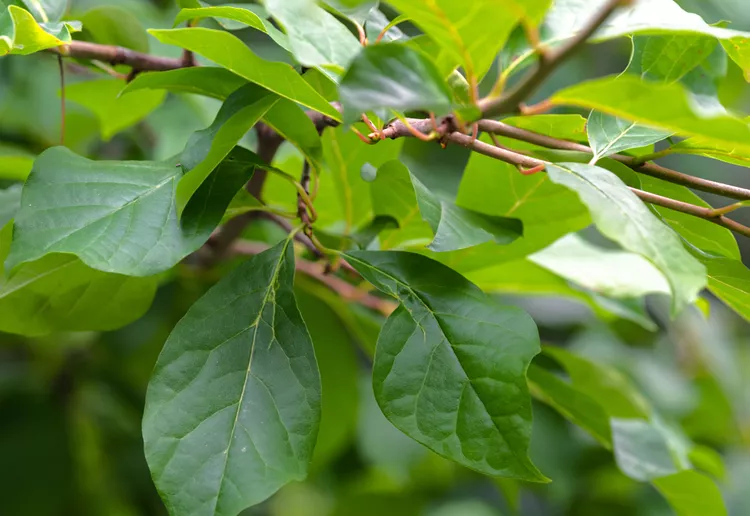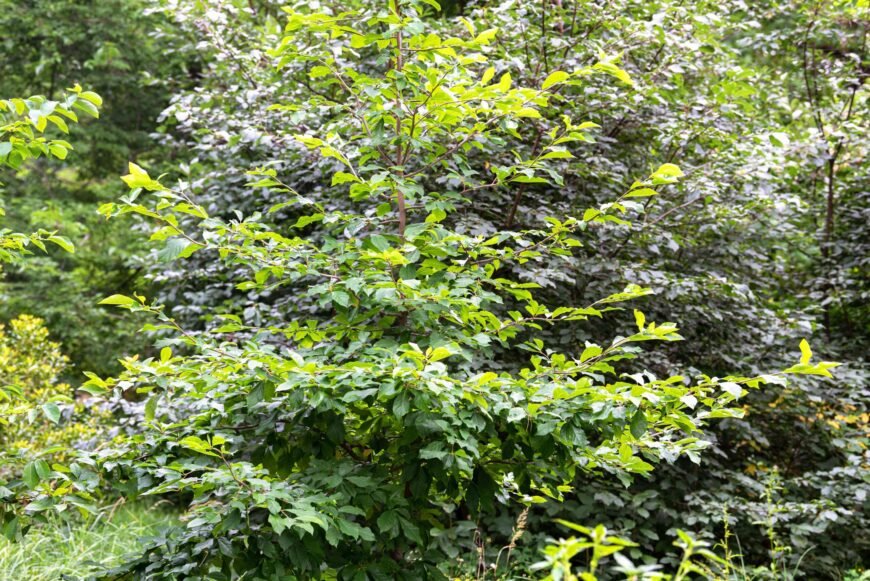| Common Name | Black gum tree, tupelo, black tupelo, sour gum tree, pepperidge |
| Botanical Name | Nyssa sylvatica |
| Family | Nyssaceae |
| Plant Type | Tree |
| Mature Size | 30-50 ft. tall, 20-30 ft. wide |
| Sun Exposure | Full, partial |
| Soil Type | Moist, well-drained |
| Soil pH | Acidic |
| Hardiness Zones | 3-9 (USDA) |
| Native Area | North America |
Black Gum Tree Care
Here are the main care requirements for growing black gum tree:
- Plant the tree in its permanent location as it is difficult to move without harming the root.
- Water regularly during the first growing season.
- Fertilize annually in the fall with a slow-release granular fertilizer.
- The pruning and fertilization requirements for this native tree are also minimal.

Planting
Plant black gum trees in an area that gets plenty of sunlight. The best time to plant them is in spring or fall. To plant, dig a hole that is about the size of the root ball, place the tree upright in the hole, and backfill the hole with soil. Water in the tree thoroughly.
Light
This tree can grow in full to partial sunlight. That means it should get at least four hours of direct sunlight on most days.
Soil
The black gum tree is tolerant of various soil types. It prefers loamy soil with an acidic pH and good drainage. It can handle a spot with poor drainage and even some standing water. The tree is moderately tolerant of clay soil, as well as gravelly or sandy soil.
Water
The tree likes moist soil and should be watered regularly when it is young to maintain even soil moisture. However, it also has some drought tolerance, and mature trees can adapt to growing in relatively dry soils.
Still, if you have a prolonged period without rainfall and your soil begins to dry out, you should water your tree.
Temperature and Humidity
Black gum trees grow naturally in a variety of climates and are hardy both to cold and to heat. Humidity usually isn’t an issue for the tree, as long as there is good air flow among its branches. Otherwise, high humidity and cramped branches can lead to fungal growth.
Fertilizer
Feed this tree annually in the fall using a slow-release granular fertilizer. In general, use two cups of fertilizer per every inch of trunk diameter, measuring the trunk at about four feet off the ground. Sprinkle the fertilizer into the soil around the tree in an area that extends 1.5 times the distance from the trunk to the tips of the branches.
Black Gum Tree Varieties
Varieties of the black gum tree include:
- ‘Zydeco Twist’: This variety features somewhat twisting branches, which really stand out during the winter months when the tree is bare.
- ‘Autumn Cascades’: This weeping variety is known for its especially attractive yellow, orange, and red fall foliage.
- ‘Wildfire’: This tree will produce red leaves throughout the growing season.
- ‘Firestarter’: A trademarked cultivar with early, vivid red fall coloring, this variety does not produce fruit.
- ‘Tupelo Tower’: This tree has a somewhat columnar growth habit and turns to shades of gold, amber, and scarlet in the fall.
Pruning
Black gum tree doesn’t require much pruning beyond trimming branches to retain your desired shape and removing any parts that are damaged, diseased, or dead. If any of the lower branches are drooping downward, you can prune those off if you wish to make walking around the tree easier.
The best time for general pruning is in the late fall or the late winter after the coldest weather has passed, though you can cut out problematic branches at any point.
Propagating Black Gum Tree
Propagating black gum tree from cuttings is difficult. Growing it from the seed yields unpredictable results—you won’t necessarily get the same attractive fall color that you admire in the parent tree.
In addition, the propagation of trademarked cultivars is prohibited. Therefore, if you want to plant a black gum tree, it is recommended to source it from a nursery.
Common Pests & Plant Diseases
Black gum tree typically doesn’t have any serious issues with pests or diseases. Keep an eye out for leaf spots, cankers, leaf miners, and scale. Look for discolored or damaged foliage, as well as abnormal-looking bark and branches.
Common Problems with Black Gum Trees
Leaf Spot
Black gum trees can be prone to leaf spot. However, newer cultivars and varieties are available to plant that are more resistant to leaf spot.
Wilted Leaves
If the leaves of your black gum tree are dry and wilted, it could be lacking moisture. Be sure to water your tree regularly when it is planted, and provide water anytime the soil is dry.
-
-
Are black gum trees messy? The tree drops a considerable amount of fruit, which litters sidewalks and needs to be picked up, or else it can become a slipping hazard. Therefore it is recommended to plant the tree away from walkways, patios, and other areas that get a lot of foot traffic.
-
-
-
What is the difference between black gum tree and sweet gum tree? They are two different species. American sweetgum (Liquidambar styraci) is a much larger forest tree that can grow 75 to 130 feet tall.
-
-
-
Do black gum trees produce gum balls? No, black gum produces small fleshy fruit, whereas the sweet gum tree produces pointy gum balls.
-
-
-
What are the pros and cons of planting black gum tree? These trees offer ornamental value and benefit local wildlife. However, they are slow-growing and tend to drop branches.
-
